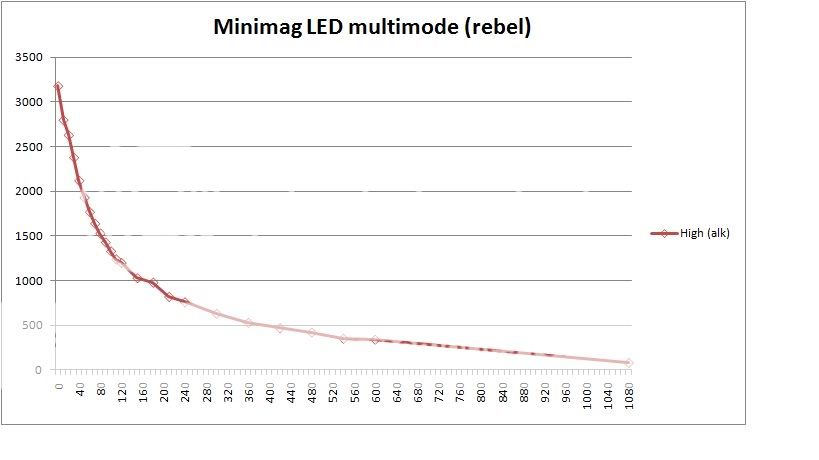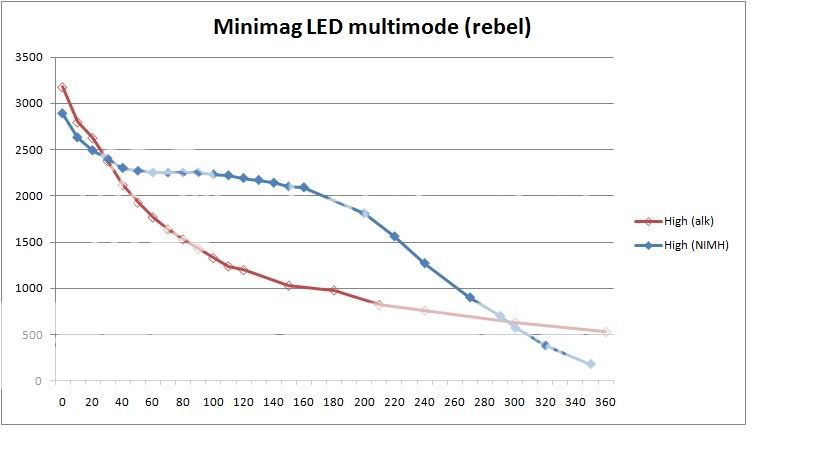So I finally got my $20 amazon light meter (by Mastech). I was planning on getting a good one, probably an extech data logger, but I'm short on cash at the moment. I'm mainly interested in testing lights that don't have runtime graphs that I can find.
For this test, I manually checked the meter every 10 minutes because I didn't want to be running in there every minute or 5 minutes. This allowed me to study in between readings.
Since these are runtime tests, I'm most interested in relative values. The measurements are in lux, but all I'm doing is aiming the flashlight at the meter, at a distance of ~10cm under a meter, in a dark closet. I have not made a light box, and due to how I'm doing these tests and with the cheap meter I'm using, I dont expect the lux values to be accurate. With that said, if I test a light that has a known lux value that somebody with better equipment has found (or the manufacturer), I can adjust the test to get an initial value close to that.
So...Minimag LED multimode. My initial lux values were high, almost 3200 when the 1m value attained by the manufacturer is 2547. The ANSI standards to state that that measurement is taken after 30 seconds and mine was initial, but even after 10 minutes, I was at 2800.
The real puzzle to me is that the light didn't last anywhere near the claimed 18 hours to 10% output. Even if I start at the 10 minute lux value (to account for the fact that I didn't measure at 30 seconds), and even if I account for the fact that I'm approximating when 10% output occured (No measurement taken between 10 and 18 hours - sleeping), it isn't close. 10% output occured at around 670 minutes (11 hours) on fresh Duracell batteries.
So why did this happen?
The meter is cheap, but this can't account for more than a small error.
My testing site (light on a shelf in a dark closet) is certainly not as good as a light box, but this shouldn't affect relative measurements of lux (If I was trying to test overall output, this setup would not work at all...).
Let me know if you have any ideas on why this large discrepancy occured.

For this test, I manually checked the meter every 10 minutes because I didn't want to be running in there every minute or 5 minutes. This allowed me to study in between readings.
Since these are runtime tests, I'm most interested in relative values. The measurements are in lux, but all I'm doing is aiming the flashlight at the meter, at a distance of ~10cm under a meter, in a dark closet. I have not made a light box, and due to how I'm doing these tests and with the cheap meter I'm using, I dont expect the lux values to be accurate. With that said, if I test a light that has a known lux value that somebody with better equipment has found (or the manufacturer), I can adjust the test to get an initial value close to that.
So...Minimag LED multimode. My initial lux values were high, almost 3200 when the 1m value attained by the manufacturer is 2547. The ANSI standards to state that that measurement is taken after 30 seconds and mine was initial, but even after 10 minutes, I was at 2800.
The real puzzle to me is that the light didn't last anywhere near the claimed 18 hours to 10% output. Even if I start at the 10 minute lux value (to account for the fact that I didn't measure at 30 seconds), and even if I account for the fact that I'm approximating when 10% output occured (No measurement taken between 10 and 18 hours - sleeping), it isn't close. 10% output occured at around 670 minutes (11 hours) on fresh Duracell batteries.
So why did this happen?
The meter is cheap, but this can't account for more than a small error.
My testing site (light on a shelf in a dark closet) is certainly not as good as a light box, but this shouldn't affect relative measurements of lux (If I was trying to test overall output, this setup would not work at all...).
Let me know if you have any ideas on why this large discrepancy occured.



